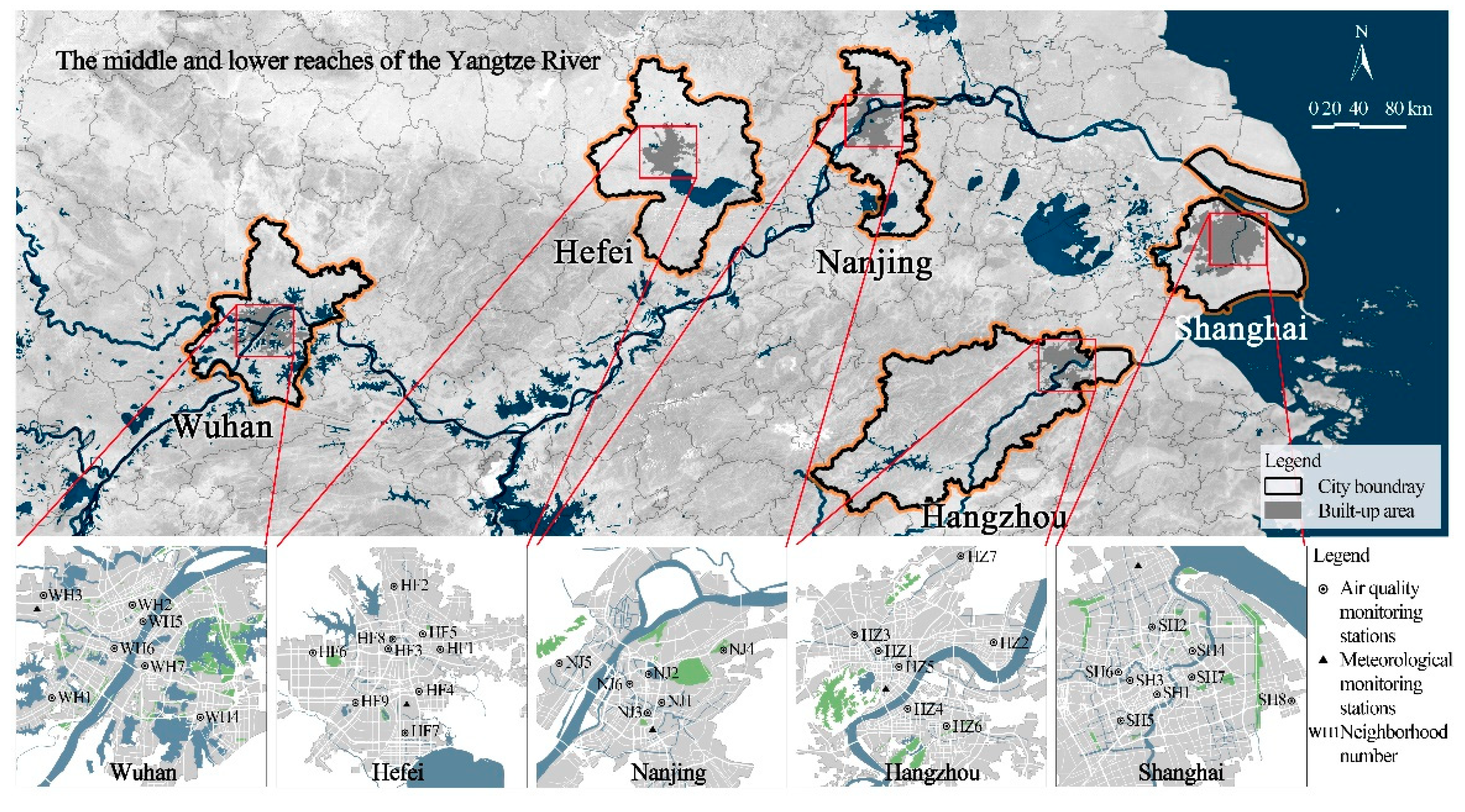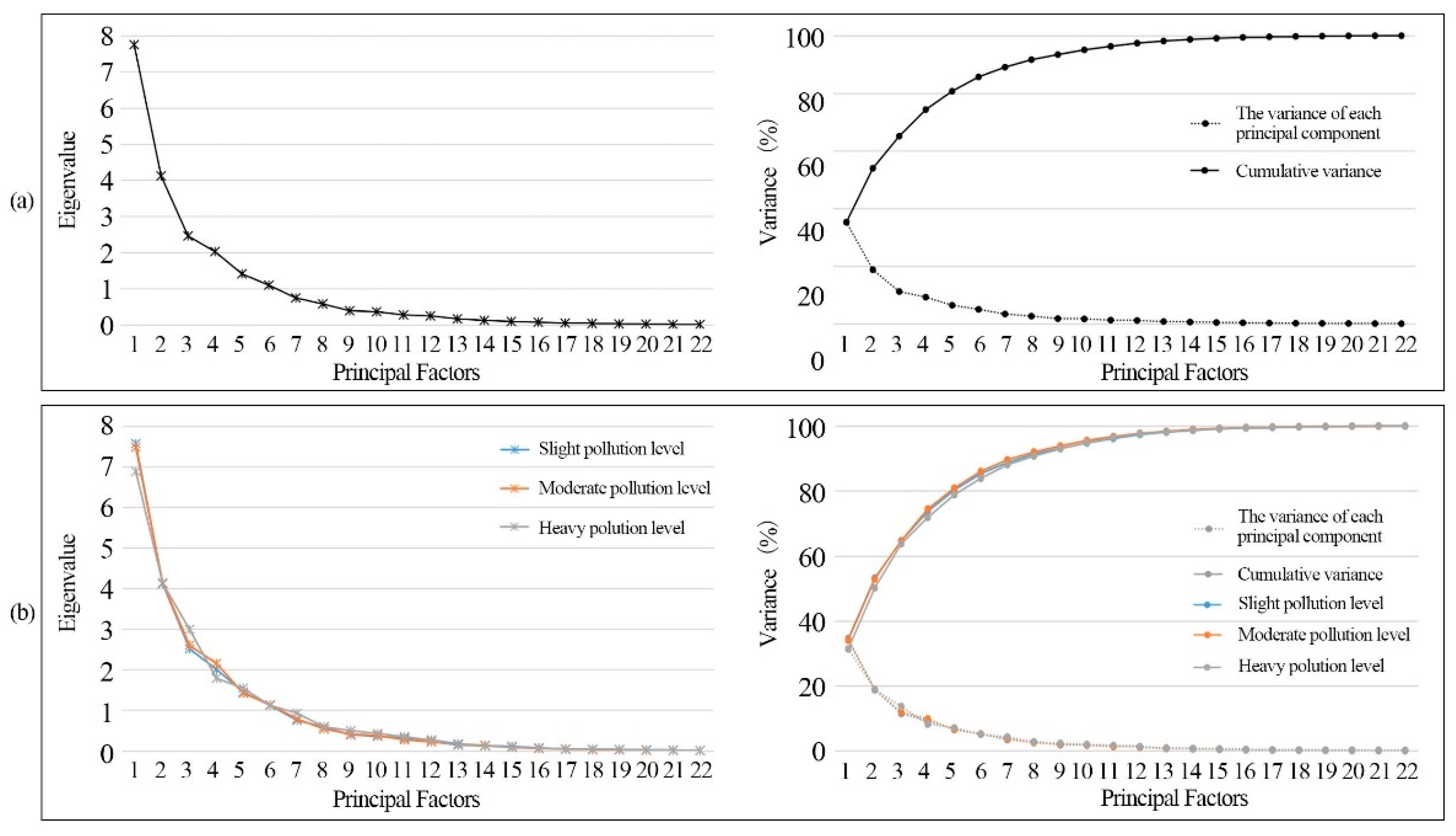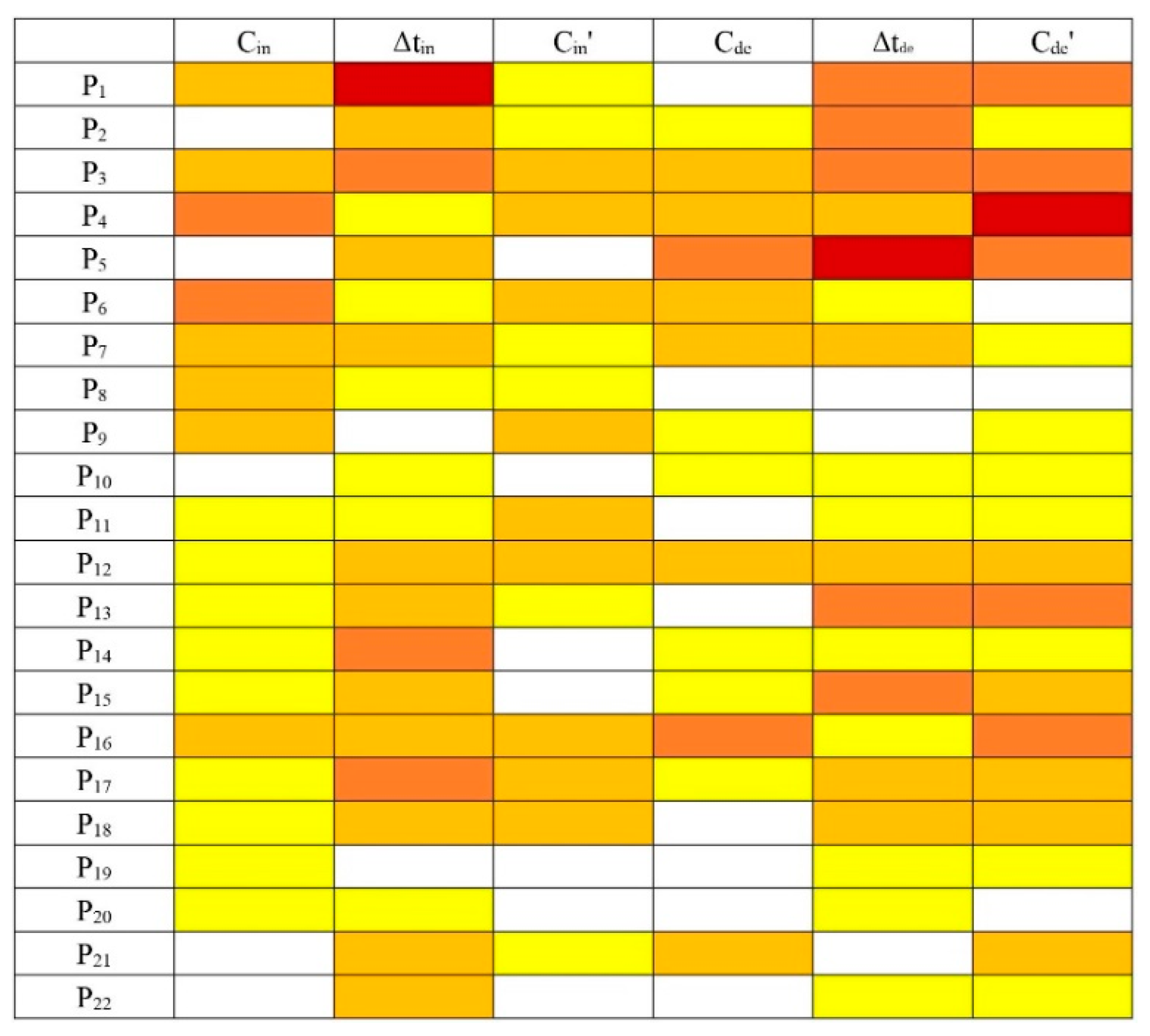PCA-Based Identification of Built Environment Factors Reducing PM2.5 Pollution in Neighborhoods of Five Chinese Megacities
Abstract
:1. Introduction
2. Materials and Methods
2.1. Study Area and Neighborhoods
2.2. PM2.5 Data Source and Processing
2.3. Built Environment Variables and Meteorological Factors
2.4. Analytical Methods
2.4.1. PCA Analysis
2.4.2. Regression Models and Evaluation
3. Results and Discussion
3.1. Results of PCA
3.1.1. Overall Characteristics of PCA
3.1.2. Principal Factors Composition
+ 0.235x12 + 0.238x13 + 0.315x14 + 0.111x15 + 0.083x16 + 0.125x17 − 0.325x18 + 0.252x19 − 0.281x20 − 0.195x21 +
0.23x22
3.2. Construction and Verification of Models
3.3. The Influence of Built Environment on PM2.5
4. Conclusions
Supplementary Materials
Author Contributions
Funding
Institutional Review Board Statement
Informed Consent Statement
Data Availability Statement
Acknowledgments
Conflicts of Interest
References
- Sundell, J.; Levin, H.; Nazaroff, W.W.; Cain, W.S.; Fisk, W.J.; Grimsrud, D.T.; Gyntelberg, F.; Li, Y.; Persily, A.K.; Pickering, A.C.; et al. Ventilation rates and health: Multidisciplinary review of the scientific literature. Indoor Air 2011, 21, 191–204. [Google Scholar] [CrossRef] [PubMed]
- Liu, Y.; Wu, J.; Yu, D. Disentangling the complex effects of socioeconomic, climatic, and urban form factors on air pollution: A case study of China. Sustainability 2018, 10, 776. [Google Scholar] [CrossRef] [Green Version]
- Tecer, L.H.; Süren, P.; Alagha, O.; Karaca, F.; Tuncel, G. Effect of meteorological parameters on fine and coarse particulate matter mass concentration in a coal-mining area in Zonguldak, Turkey. J. Air Waste Manage. Assoc. 2008, 58, 543–552. [Google Scholar] [CrossRef]
- Cheng, Z.; Li, L.; Liu, J. Identifying the spatial effects and driving factors of urban PM2.5 pollution in China. Ecol. Indic. 2017, 82, 61–75. [Google Scholar] [CrossRef]
- Huang, Y.; Shen, H.; Chen, H.; Wang, R.; Zhang, Y.; Su, S.; Chen, Y.; Lin, N.; Zhuo, S.; Zhong, Q.; et al. Quantification of global primary emissions of PM2.5, PM10, and TSP from combustion and industrial process sources. Environ. Sci. Technol. 2014, 48, 13834–13843. [Google Scholar] [CrossRef]
- Liu, Z.; Wang, Y.; Hu, B.; Ji, D.; Zhang, J.; Wu, F.; Wan, X.; Wang, Y. Source appointment of fine particle number and volume concentration during severe haze pollution in Beijing in January 2013. Environ. Sci. Pollut. Res. 2016, 23, 6845–6860. [Google Scholar] [CrossRef] [PubMed]
- Romero, H.; Ihl, M.; Rivera, A.; Zalazar, P.; Azocar, P. Rapid urban growth, land-use changes and air pollution in Santiago, Chile. Atmos. Environ. 1999, 33, 4039–4047. [Google Scholar] [CrossRef]
- Aslam, M.Y.; Krishna, K.R.; Beig, G.; Tinmaker, M.I.R.; Chate, D.M. Diurnal evolution of urban heat island and its impact on air quality by using ground observations (SAFAR) over New Delhi. Open J. Air Pollut. 2017, 6, 52–64. [Google Scholar] [CrossRef] [Green Version]
- Yuan, M.; Song, Y.; Huang, Y.; Shen, H.; Li, T. Exploring the association between the built environment and remotely sensed PM2.5 concentrations in urban areas. J. Clean Prod. 2019, 220, 1014–1023. [Google Scholar] [CrossRef]
- Yang, H.; Chen, W.; Liang, Z. Impact of land use on PM2.5 pollution in a representative city of middle China. Int. J. Environ. Res. Public Health 2017, 14, 462. [Google Scholar] [CrossRef]
- Łowicki, D. Landscape pattern as an indicator of urban air pollution of particulate matter in Poland. Ecol. Indic. 2019, 97, 17–24. [Google Scholar] [CrossRef]
- Lu, D.; Mao, W.; Yang, D.; Zhao, J.; Xu, J. Effects of land use and landscape pattern on PM2.5 in Yangtze River Delta, China. Atmos. Pollut. Res. 2018, 9, 705–713. [Google Scholar] [CrossRef]
- Wu, J.; Xie, W.; Li, W.; Li, J. Effects of urban landscape pattern on PM2.5 pollution-A Beijing case study. PLoS ONE 2015, 10, e0142449. [Google Scholar] [CrossRef] [Green Version]
- Yang, S.; Wu, H.; Chen, J.; Lin, X.; Lu, T. Optimization of PM2.5 estimation using landscape pattern information and land use regression model in Zhejiang, China. Atmosphere 2018, 9, 47. [Google Scholar] [CrossRef] [Green Version]
- Fan, C.; Tian, L.; Zhou, L.; Hou, D.; Song, Y.; Qiao, X.; Li, J. Examining the impacts of urban form on air pollutant emissions: Evidence from China. J. Environ. Manag. 2018, 212, 405–414. [Google Scholar] [CrossRef] [PubMed]
- Lee, C. Impacts of multi-scale urban form on PM2.5 concentrations using continuous surface estimates with high-resolution in U.S. metropolitan areas. Landsc. Urban Plann. 2020, 204, 103935. [Google Scholar] [CrossRef]
- Liu, Y.; Wu, J.; Yu, D.; Ma, Q. The relationship between urban form and air pollution depends on seasonality and city size. Environ. Sci. Pollut. Res. 2018, 25, 15554–15567. [Google Scholar] [CrossRef]
- Chen, M.; Dai, F.; Yang, B.; Zhu, S. Effects of neighborhood green space on PM2.5 mitigation: Evidence from five megacities in China. Build. Environ. 2019, 156, 33–45. [Google Scholar] [CrossRef]
- Hu, H.; Chen, Q.; Qian, Q.; Lin, C.; Chen, Y.; Tian, W. Impacts of traffic and street characteristics on the exposure of cycling commuters to PM2.5 and PM10 in urban street environments. Build. Environ. 2021, 188, 107476. [Google Scholar] [CrossRef]
- Yang, J.; Shi, B.; Shi, Y.; Marvin, S.; Zheng, Y.; Xia, G. Air pollution dispersal in high density urban areas: Research on the triadic relation of wind, air pollution, and urban form. Sustain. Cities Soc. 2020, 54, 101941. [Google Scholar] [CrossRef]
- Edussuriya, R.; Chan, A.; Ye, A. Urban morphology and air quality in dense residential environments in Hong Kong. Part I: District-level analysis. Atmos. Environ. 2011, 45, 4789–4803. [Google Scholar] [CrossRef]
- Das, M.; Das, A. Assessing the relationship between local climatic zones (LCZs) and land surface temperature (LST)—A case study of Sriniketan-Santiniketan Planning Area (SSPA), West Bengal, India. Urban Clim. 2020, 32, 100591. [Google Scholar] [CrossRef]
- Kotharkar, R.; Bagade, A.; Singh, P.R. A systematic approach for urban heat island mitigation strategies in critical local climate zones of an Indian city. Urban Clim. 2020, 34, 100701. [Google Scholar] [CrossRef]
- Johnson, S.; Ross, Z.; Kheirbek, I.; Ito, K. Characterization of intra-urban spatial variation in observed summer ambient temperature from the New York City Community Air Survey. Urban Clim. 2020, 31, 100583. [Google Scholar] [CrossRef]
- Perera, N.G.R.; Emmanuel, R. A “Local Climate Zone” based approach to urban planning in Colombo, Sri Lanka. Urban Clim. 2018, 23, 188–203. [Google Scholar] [CrossRef] [Green Version]
- Ziaul, S.; Pal, S. Analyzing control of respiratory particulate matter on Land Surface Temperature in local climatic zones of English Bazar Municipality and Surroundings. Urban Clim. 2018, 24, 34–50. [Google Scholar] [CrossRef]
- Zhou, X.; Okaze, T.; Ren, C.; Cai, M.; Ishida, Y.; Watanabe, H.; Mochida, A. Evaluation of urban heat islands using local climate zones and the influence of sea-land breeze. Sust. Cities Soc. 2020, 55, 102060. [Google Scholar] [CrossRef]
- Ng, E. Policies and technical guidelines for urban planning of high-density cities-air ventilation assessment (AVA) of Hong Kong. Build. Environ. 2009, 44, 1478–1488. [Google Scholar] [CrossRef]
- Zhai, L.; Li, S.; Zhou, B.; Sang, H.; Fang, X.; Xu, S. An improved geographically weighted regression model for PM2.5 concentration estimation in large areas. Atmos. Environ. 2018, 181, 145–154. [Google Scholar] [CrossRef]
- Han, R.Y.; Chen, J.; Wang, B.; Wu, D.; Tang, M. LUR models for simulating the spatial distribution of PM2.5 concentration in Zhejiang Province. Bull. Sci. Technol. 2016, 32, 215–220. [Google Scholar]
- Zhang, M.; Ma, Y.; Wang, L.; Gong, W.; Hu, B.; Shi, Y. Spatial-temporal characteristics of aerosol loading over the Yangtze River Basin during 2001-2015. Int. J. Climatol. 2017, 38, 2138–2152. [Google Scholar] [CrossRef]
- Chen, M.; Dai, F.; Yang, B.; Zhu, S. Effects of urban green space morphological pattern on variation of PM2.5 concentration in neighborhoods of five Chinese megacities. Build. Environ. 2019, 158, 1–15. [Google Scholar] [CrossRef]
- Lei, Y.; Duan, Y.; He, D. Effects of urban greenspace patterns on particulate matter pollution in metropolitan Zhengzhou in Henan, China. Atmosphere 2018, 9, 199. [Google Scholar] [CrossRef] [Green Version]
- Zhao, C.; Fu, G.; Liu, X.; Fu, F. Urban planning indicators, morphology and climate indicators: A case study for a north-south transect of Beijing, China. Build. Environ. 2011, 46, 1174–1183. [Google Scholar] [CrossRef]
- Chen, M.; Bai, J.; Zhu, S.; Yang, B.; Dai, F. The influence of neighborhood-level urban morphology on PM2.5 variation based on random forest regression. Atmos. Pollut. Res. 2021, 12, 101147. [Google Scholar] [CrossRef]
- Clark, L.P.; Millet, D.B.; Marshall, J.D. Air quality and urban form in US urban areas: Evidence from regulatory monitors. Environ. Sci. Technol. 2011, 45, 7028–7035. [Google Scholar] [CrossRef]
- Wang, F.; Peng, Y.; Jiang, C. Influence of road patterns on PM2.5 concentrations and the available solutions: The case of Beijing city, China. Sustainability 2017, 9, 217. [Google Scholar] [CrossRef] [Green Version]
- Mei, D.; Deng, Q.; Wen, M.; Fang, Z. Evaluating dust particle transport performance within urban street canyons with different building heights. Aerosol Air Qual. Res. 2016, 16, 1483–1496. [Google Scholar] [CrossRef] [Green Version]
- Svensson, M.K. Sky viewfactor analysis-implications for urban air temperature differences. Meteorol. Appl. 2004, 11, 201–211. [Google Scholar] [CrossRef]
- G’al, T.; Lindberg, F.; Unger, J. Computing continuous sky view factors using 3D urban raster and vector databases: Comparison and application to urban climate. Theor. Appl. Climatol. 2009, 95, 111–123. [Google Scholar] [CrossRef]
- Olvera, H.A.; Garcia, M.; Li, W.W.; Yang, H.; Amaya, M.A.; Myers, O.; Burchiel, S.W.; Berwick, M.; Pingitore, N.E. Principal component analysis optimization pf a PM2.5 land use regression model with small monitoring network. Sci. Total Environ. 2012, 425, 27–34. [Google Scholar] [CrossRef] [PubMed] [Green Version]
- Zhao, L.; Li, T.; Przybysz, A.; Guan, Y.; Ji, P.; Ren, B.; Zhu, C. Effect of urban lake wetlands and neighboring urban greenery on air PM10 and PM2.5 mitigation. Build. Environ. 2021, 206, 108291. [Google Scholar] [CrossRef]
- Zhu, C.; Przybysz, A.; Chen, Y.; Guo, H.; Chen, Y.; Zeng, Y. Effect of spatial heterogeneity of plant communities on air PM10 and PM2.5 in an urban forest park in Wuhan, China. Urban For. Urban Gree. 2019, 46, 126487. [Google Scholar] [CrossRef]
- McDonald, A.G.; Bealey, W.J.; Fowler, D.; Dragosits, U.; Skiba, U.; Smith, R.I.; Donovan, R.G.; Brett, H.E.; Hewitt, C.N.; Nemitz, E. Quantifying the effect of urban tree planting on concentrations and depositions of PM10 in two UK conurbations. Atmos. Environ. 2007, 41, 8455–8467. [Google Scholar] [CrossRef]
- Shi, Y.; Xie, X.; Fung, J.C.H.; Ng, E. Identifying critical building morphological design factors of street-level air pollution dispersion in high-density built environment using mobile monitoring. Build. Environ. 2018, 128, 248–259. [Google Scholar] [CrossRef] [Green Version]
- Dai, F.; Chen, M.; Yang, B. Spatiotemporal variations of PM2.5 concentration at the neighborhood level in five Chinese megacities. Atmos. Pollut. Res. 2020, 11, 190–202. [Google Scholar] [CrossRef]






| Dimension | Independent Variables | Dependent Variables | ||
|---|---|---|---|---|
| Green Space | Gray Space | Meteorological Factors | ||
| Quantity | TCR (x1), GCR (x2) | HSCR (x10) | Ta (x20), RH (x21), V (x22) | Cin (y1), Δtin (y2), Cin’ (y3), Cde (y4), Δtde (y5), Cde’ (y6) |
| Spatial Pattern | Core (x3), Islet (x4), Perforation (x5), Edge (x6), Loop (x7), Bridge (x8), Branch (x9) | BD_1 (x11), BD_2 (x12), BD_3 (x13), FAR (x14), H (x15), Hσ (x16), BEI (x17), SVF (x18), RD (x19) | ||
| Dependent Variable | Principal Factors | Constant | p-Value | F-Value | Adj_R2 |
|---|---|---|---|---|---|
| Cin | P3(0.058,0.429) ***, P4(0.060,0.361) **, P20(−0.521,−0.340) ** | 1.424 *** | 0.002 | 6.492 | 0.347 |
| Δtin | P1(−0.037,−0.182) *, P3(0.142,0.391) ***, P4(0.089,0.199) *, P5(−0.146,−0.283) **, P7(−0.118,−0.189) *, P13(−0.367,−0.251) **, P15(0.353,0.191) *, P16(−0.586,−0.284) **, P17(0.654,0.246) **, P18 (−0.729, −0.227) **, P22 (3.749, 0.295) ** | 7.725 *** | 0.000 | 6.962 | 0.679 |
| Cin’ | P11(−0.021,−0.416) **, P16(0.027,0.298) *, P18(0.041,0.286) * | 0.199 *** | 0.015 | 4.128 | 0.232 |
| Cde | P4(−0.010,−0.354) ***, P5(0.017,0.532) ***, P12(0.020,0.287) **, P16(0.045,0.346) ***, P21(−0.118,−0.256) ** | 0.539 *** | 0.000 | 10.520 | 0.606 |
| Δtde | P1(−0.053,−0.269) ***, P2(−0.069,−0.253) ***, P3(0.079,0.222) **, P4(0.200,0.457) ***, P5(−0.154,−0.302) ***, P10(0.150,0.153) *, P13(0.430,0.299) ***, P15(0.713,0.393) ***, P17(0.788,0.301) ***, P18(0.449,0.142) *, P20(−0.692,−0.172) ** | 6.508 *** | 0.000 | 13.228 | 0.813 |
| Cde’ | P3(−0.002,−0.265) ***, P4(−0.003,−0.374) ***, P5(0.004,0.415) ***, P10(−0.004,−0.194) **, P13(−0.010,−0.327) ***, P15(−0.012,−0.326) ***, P16(0.008,0.176) *, P17(−0.021,−0.385) ***, P18(−0.017,−0.251) *** | 0.100 *** | 0.000 | 12.783 | 0.774 |
Publisher’s Note: MDPI stays neutral with regard to jurisdictional claims in published maps and institutional affiliations. |
© 2022 by the authors. Licensee MDPI, Basel, Switzerland. This article is an open access article distributed under the terms and conditions of the Creative Commons Attribution (CC BY) license (https://creativecommons.org/licenses/by/4.0/).
Share and Cite
Chen, M.; Dai, F. PCA-Based Identification of Built Environment Factors Reducing PM2.5 Pollution in Neighborhoods of Five Chinese Megacities. Atmosphere 2022, 13, 115. https://doi.org/10.3390/atmos13010115
Chen M, Dai F. PCA-Based Identification of Built Environment Factors Reducing PM2.5 Pollution in Neighborhoods of Five Chinese Megacities. Atmosphere. 2022; 13(1):115. https://doi.org/10.3390/atmos13010115
Chicago/Turabian StyleChen, Ming, and Fei Dai. 2022. "PCA-Based Identification of Built Environment Factors Reducing PM2.5 Pollution in Neighborhoods of Five Chinese Megacities" Atmosphere 13, no. 1: 115. https://doi.org/10.3390/atmos13010115





